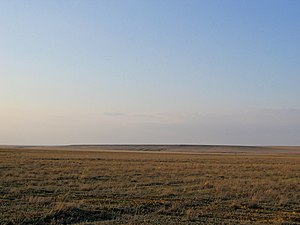Kazakh Steppe
(Redirected from
Kazakh steppe
)| Kazakh Steppe | |
|---|---|
 | |
 Ecoregion territory (in purple); WWF ID# PA0810 | |
| Ecology | |
| Realm | Palearctic |
| Biome | Temperate grasslands, savannas, and shrublands |
| Geography | |
| Area | 804,450 km2 (310,600 sq mi) |
| Countries | Kazakhstan and Russia |
| Coordinates | 52°53′46″N 71°39′00″E / 52.896°N 71.650°E |
The Kazakh Steppe (
Eurasian steppe. The Kazakh Steppe is an ecoregion of the temperate grasslands, savannas, and shrublands biome in the Palearctic realm
. Before the mid-19th century, it was called the Kirghiz steppe, 'Kirghiz' being an old Russian word for the Kazakhs.
Setting
The
Turan Lowland lies in the southwestern part of the steppe, but elevation increases as one travels east or to the northern parts of the steppe, with a few exceptions.[citation needed
]
The
Kokshetau Massif in north-central Kazakhstan harbors an enclave of the Kazakh upland, distinct from the Kazakh steppe which surrounds it at lower elevations.[citation needed
]
Climate
The region has a
precipitation in an average year, with more falling in the northern areas. Average maximum temperatures range from 20 to 26 °C (68.0 to 78.8 °F) in July, and from −12 to −18 °C (10.4 to −0.4 °F) in January. Very high winds sweep across the plains at times.[citation needed
]
| Climate data for Astana | |||||||||||||
|---|---|---|---|---|---|---|---|---|---|---|---|---|---|
| Month | Jan | Feb | Mar | Apr | May | Jun | Jul | Aug | Sep | Oct | Nov | Dec | Year |
| Record high °C (°F) | 4 (39) |
5 (41) |
22 (72) |
30 (86) |
36 (97) |
40 (104) |
42 (108) |
39 (102) |
36 (97) |
27 (81) |
19 (66) |
5 (41) |
42 (108) |
| Mean daily maximum °C (°F) | −12 (10) |
−11 (12) |
−4 (25) |
9 (48) |
19 (66) |
25 (77) |
27 (81) |
24 (75) |
18 (64) |
8 (46) |
−2 (28) |
−9 (16) |
7 (45) |
| Daily mean °C (°F) | −15 (5) |
−15 (5) |
−9 (16) |
5 (41) |
13 (55) |
19 (66) |
21 (70) |
18 (64) |
12 (54) |
4 (39) |
−6 (21) |
−12 (10) |
3 (37) |
| Mean daily minimum °C (°F) | −21 (−6) |
−21 (−6) |
−15 (5) |
−2 (28) |
5 (41) |
11 (52) |
13 (55) |
11 (52) |
5 (41) |
−1 (30) |
−11 (12) |
−18 (0) |
−3 (27) |
| Record low °C (°F) | −52 (−62) |
−49 (−56) |
−38 (−36) |
−28 (−18) |
−11 (12) |
−2 (28) |
2 (36) |
−2 (28) |
−8 (18) |
−26 (−15) |
−39 (−38) |
−44 (−47) |
−52 (−62) |
| Average precipitation mm (inches) | 22 (0.9) |
14 (0.6) |
19 (0.7) |
21 (0.8) |
31 (1.2) |
40 (1.6) |
50 (2.0) |
37 (1.5) |
26 (1.0) |
27 (1.1) |
20 (0.8) |
22 (0.9) |
327 (12.9) |
| [citation needed] | |||||||||||||
Flora
Because of low rainfall, the steppe has few trees, and consists of mostly
Fauna
Animals that can be found in the steppes of Kazakhstan include the
People

The western part of the Kazakh Steppe is very sparsely populated, with between two and three people per 1 km2 (0.39 sq mi). As one heads east across the plains, the population density increases to between four and seven people per 1 km2 (0.39 sq mi).
space launch facility, Baikonur Cosmodrome.[11]
In popular culture
The movie Tulpan was shot and set in the Kazakh Steppe.[citation needed]
See also
- Saryarka — Steppe and Lakes of Northern Kazakhstan
- Steppe Route
- List of ecoregions in Russia
References
- ^ "Kazakh steppe". GlobalSpecies.org. Archived from the original on October 19, 2018. Retrieved October 18, 2018.
- ^ "Kazakh steppe, Asia - Kazakhstan and Russia". World Wildlife Federation. Retrieved October 18, 2018.
- ^ "About the Kazakh Steppe". kazakhsteppe.com. Retrieved October 18, 2018.
- ^ "Saiga antelope". Retrieved 28 October 2017.
- ^ Bogoljoebov, A.S. (2001). Sibirskaja kosoelja - Capreolus pygargus Geraadpleegd op 21 december 2015.
- ^ Savtsjenko, A.P. & Savtsjenko, I.A. (2012). Kosoelja sibirskaja. Geraadpleegd op 21 december 2015
- . Retrieved 12 November 2021.
- ^ Mongolian gerbil
- ^ "Testudo horsfieldii". The Reptile Database. Retrieved 2022-03-25.
- ^ Lee, Davis S. (2010). "Testudostan: Our Post-Cold War Global Exploitation of a Noble Tortoise" (PDF). Bull. Chicago Herp. Soc.: 45(1):1-9. Retrieved 16 April 2023.
- ^ "Baikonur Cosmodrome 45.9 N 63.3 E". FAS.org. Federation of American Scientists (FAS). Archived from the original on 14 August 2016. Retrieved 19 July 2014.
External links
- CIA, The World Factbook, 2004
- World Wildlife Fund, ed. (2001). "Kazakh steppe". WildWorld Ecoregion Profile. National Geographic Society. Archived from the original on 2010-03-08.
- Saudi Aramco World, [1]
- surfbirds.com, [2]
- Holidays in Kazakhstan
